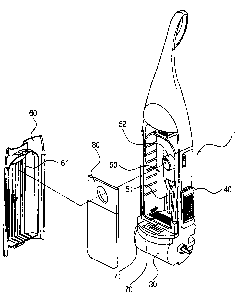Une partie des informations de ce site Web a été fournie par des sources externes. Le gouvernement du Canada n'assume aucune responsabilité concernant la précision, l'actualité ou la fiabilité des informations fournies par les sources externes. Les utilisateurs qui désirent employer cette information devraient consulter directement la source des informations. Le contenu fourni par les sources externes n'est pas assujetti aux exigences sur les langues officielles, la protection des renseignements personnels et l'accessibilité.
L'apparition de différences dans le texte et l'image des Revendications et de l'Abrégé dépend du moment auquel le document est publié. Les textes des Revendications et de l'Abrégé sont affichés :
| (12) Demande de brevet: | (11) CA 2385979 |
|---|---|
| (54) Titre français: | STRUCTURE DE CIRCULATION D'AIR POUR ASPIRATEUR VERTICAL |
| (54) Titre anglais: | AIR FLOW STRUCTURE FOR AN UPRIGHT-TYPE VACUUM CLEANER |
| Statut: | Réputée abandonnée et au-delà du délai pour le rétablissement - en attente de la réponse à l’avis de communication rejetée |
| (51) Classification internationale des brevets (CIB): |
|
|---|---|
| (72) Inventeurs : |
|
| (73) Titulaires : |
|
| (71) Demandeurs : |
|
| (74) Agent: | SMART & BIGGAR LP |
| (74) Co-agent: | |
| (45) Délivré: | |
| (22) Date de dépôt: | 2002-05-10 |
| (41) Mise à la disponibilité du public: | 2003-07-31 |
| Requête d'examen: | 2003-12-09 |
| Licence disponible: | S.O. |
| Cédé au domaine public: | S.O. |
| (25) Langue des documents déposés: | Anglais |
| Traité de coopération en matière de brevets (PCT): | Non |
|---|
| (30) Données de priorité de la demande: | ||||||
|---|---|---|---|---|---|---|
|
An air flow structure for an upright-type vacuum cleaner having a body
divided by a partition into a dust-collecting chamber having a dust bag and a
motor
driving chamber having a motor; an air suction port protruded at an upper part
of the
dust-collecting chamber in order to draw air thereinto, and having the dust
bag
disposed around the air suction port; a dust cover to cover the dust-
collecting
chamber and having a plurality of ribs disposed therein in a lengthwise
direction, a
concaved portion formed at a rear wall of the dust-collecting chamber in a
lengthwise direction, and a grill portion formed between the dust-collecting
chamber
and the motor driving chamber in order to allow the air of the dust-collecting
chamber to flow to the motor driving chamber.
Note : Les revendications sont présentées dans la langue officielle dans laquelle elles ont été soumises.
Note : Les descriptions sont présentées dans la langue officielle dans laquelle elles ont été soumises.

2024-08-01 : Dans le cadre de la transition vers les Brevets de nouvelle génération (BNG), la base de données sur les brevets canadiens (BDBC) contient désormais un Historique d'événement plus détaillé, qui reproduit le Journal des événements de notre nouvelle solution interne.
Veuillez noter que les événements débutant par « Inactive : » se réfèrent à des événements qui ne sont plus utilisés dans notre nouvelle solution interne.
Pour une meilleure compréhension de l'état de la demande ou brevet qui figure sur cette page, la rubrique Mise en garde , et les descriptions de Brevet , Historique d'événement , Taxes périodiques et Historique des paiements devraient être consultées.
| Description | Date |
|---|---|
| Demande non rétablie avant l'échéance | 2007-08-17 |
| Inactive : Morte - Taxe finale impayée | 2007-08-17 |
| Réputée abandonnée - omission de répondre à un avis sur les taxes pour le maintien en état | 2007-05-10 |
| Réputée abandonnée - les conditions pour l'octroi - jugée non conforme | 2006-08-17 |
| Inactive : CIB de MCD | 2006-03-12 |
| Un avis d'acceptation est envoyé | 2006-02-17 |
| Lettre envoyée | 2006-02-17 |
| Un avis d'acceptation est envoyé | 2006-02-17 |
| Inactive : Approuvée aux fins d'acceptation (AFA) | 2006-01-10 |
| Lettre envoyée | 2003-12-22 |
| Exigences pour une requête d'examen - jugée conforme | 2003-12-09 |
| Toutes les exigences pour l'examen - jugée conforme | 2003-12-09 |
| Requête d'examen reçue | 2003-12-09 |
| Demande publiée (accessible au public) | 2003-07-31 |
| Inactive : Page couverture publiée | 2003-07-30 |
| Inactive : CIB en 1re position | 2002-08-08 |
| Inactive : Certificat de dépôt - Sans RE (Anglais) | 2002-06-20 |
| Lettre envoyée | 2002-06-20 |
| Demande reçue - nationale ordinaire | 2002-06-20 |
| Date d'abandonnement | Raison | Date de rétablissement |
|---|---|---|
| 2007-05-10 | ||
| 2006-08-17 |
Le dernier paiement a été reçu le 2006-04-13
Avis : Si le paiement en totalité n'a pas été reçu au plus tard à la date indiquée, une taxe supplémentaire peut être imposée, soit une des taxes suivantes :
Les taxes sur les brevets sont ajustées au 1er janvier de chaque année. Les montants ci-dessus sont les montants actuels s'ils sont reçus au plus tard le 31 décembre de l'année en cours.
Veuillez vous référer à la page web des
taxes sur les brevets
de l'OPIC pour voir tous les montants actuels des taxes.
| Type de taxes | Anniversaire | Échéance | Date payée |
|---|---|---|---|
| Enregistrement d'un document | 2002-05-10 | ||
| Taxe pour le dépôt - générale | 2002-05-10 | ||
| Requête d'examen - générale | 2003-12-09 | ||
| TM (demande, 2e anniv.) - générale | 02 | 2004-05-10 | 2004-04-19 |
| TM (demande, 3e anniv.) - générale | 03 | 2005-05-10 | 2005-04-26 |
| TM (demande, 4e anniv.) - générale | 04 | 2006-05-10 | 2006-04-13 |
Les titulaires actuels et antérieures au dossier sont affichés en ordre alphabétique.
| Titulaires actuels au dossier |
|---|
| SAMSUNG KWANGJU ELECTRONICS CO., LTD. |
| Titulaires antérieures au dossier |
|---|
| HYUNG-IL JEON |
| IL-WON YANG |
| JUNG-SEON PARK |